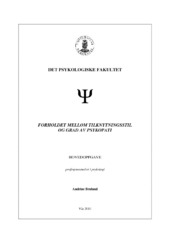| dc.contributor.author | Bruland, Andrine | |
| dc.date.accessioned | 2013-11-05T14:28:56Z | |
| dc.date.available | 2013-11-05T14:28:56Z | |
| dc.date.issued | 2011-04-15 | eng |
| dc.date.submitted | 2011-04-15 | eng |
| dc.identifier.uri | https://hdl.handle.net/1956/7488 | |
| dc.description.abstract | The aim of this study was to investigate possible differences in attachment style in subjects of high and low levels of psychopathy. A total of 103 convicted male inmates from Bergen Prison answered the Self-Report Psychopathy scale (SRP-III) to identify their levels of psychopathy symptoms, and Experience in Close Relationships (ECR-R) to identify their attachment style (anxious/avoidant). The subjects were classified into either the high score (HS) or low score (LS) psychopathy group, based on the median split of the sample. For the LS-group, results showed a significant lower score on the avoidant dimension compared to the anxious dimension (p<.00). Participants in the HS-group did not differ on the two dimensions, but had a significant higher score on the avoidant dimension compared to the LSgroup (p<.00). Results are discussed in terms of how the relationship between attachment and psychopathy may have clinical implications, as well as how this knowledge can contribute to a deeper understanding of the development of psychopathy. | en_US |
| dc.description.abstract | Denne studiens formål var å undersøke om det er forskjeller på tilknytningsstil hos personer med høy og lav grad av psykopati. 103 mannlige domfelte i Bergen Fengsel ble undersøkt med Self- Report Psychopathy scale (SRP-III), og Experience in Close Relationships (ECR-R) for å identifisere henholdsvis grad av psykopati og tilknytningsstil. Basert på medianen ble deltakerene delt inn i to grupper; lav (LS) og høy (HS) score på psykopatisymptom. Resultatene viste at de i LS- gruppen hadde en signifikant lavere score på dimensjonen unngående tilknytning enn på engstelig tilknytning (p<.00). Deltakerne i HS-gruppa hadde ingen forskjell i score på de to dimensjonene, men scorte signifikant høyere på den unngående tilknytningsdimensjonen enn deltakerne i LS- gruppen (p<.00). Funnene diskuteres i lys av hvordan relasjonen mellom tilknytningsstil og grad av psykopati kan ha kliniske implikasjoner, samt hvilken betydning denne kunnskapen kan ha med hensyn til en dypere forståelse for psykopatiens utvikling. | en_US |
| dc.format.extent | 159431 bytes | eng |
| dc.format.mimetype | application/pdf | eng |
| dc.language.iso | nob | eng |
| dc.publisher | The University of Bergen | eng |
| dc.subject | Psykopati | eng |
| dc.subject | Tilknytning | eng |
| dc.subject | Kriminelle | eng |
| dc.title | Forholdet mellom tilknytningsstil og grad av psykopati | eng |
| dc.type | Master thesis | |
| dc.rights.holder | Copyright the author. All rights reserved | |
| dc.description.localcode | PSYK300 | |
| dc.description.localcode | PRPSYK | |
| dc.subject.nus | 736102 | eng |
| fs.subjectcode | PSYK300 | |
